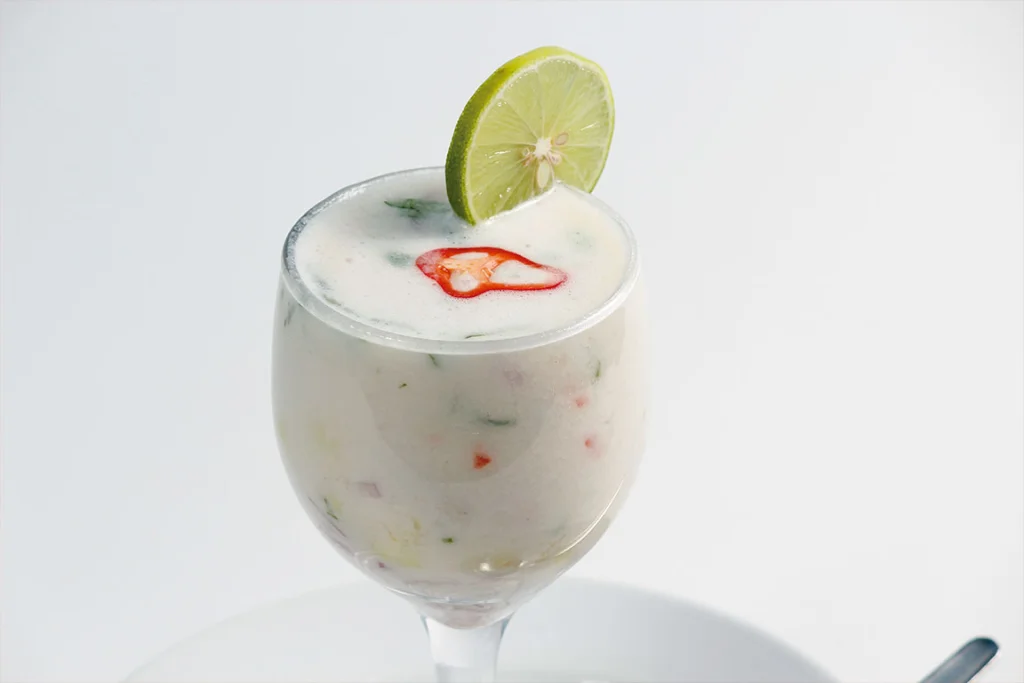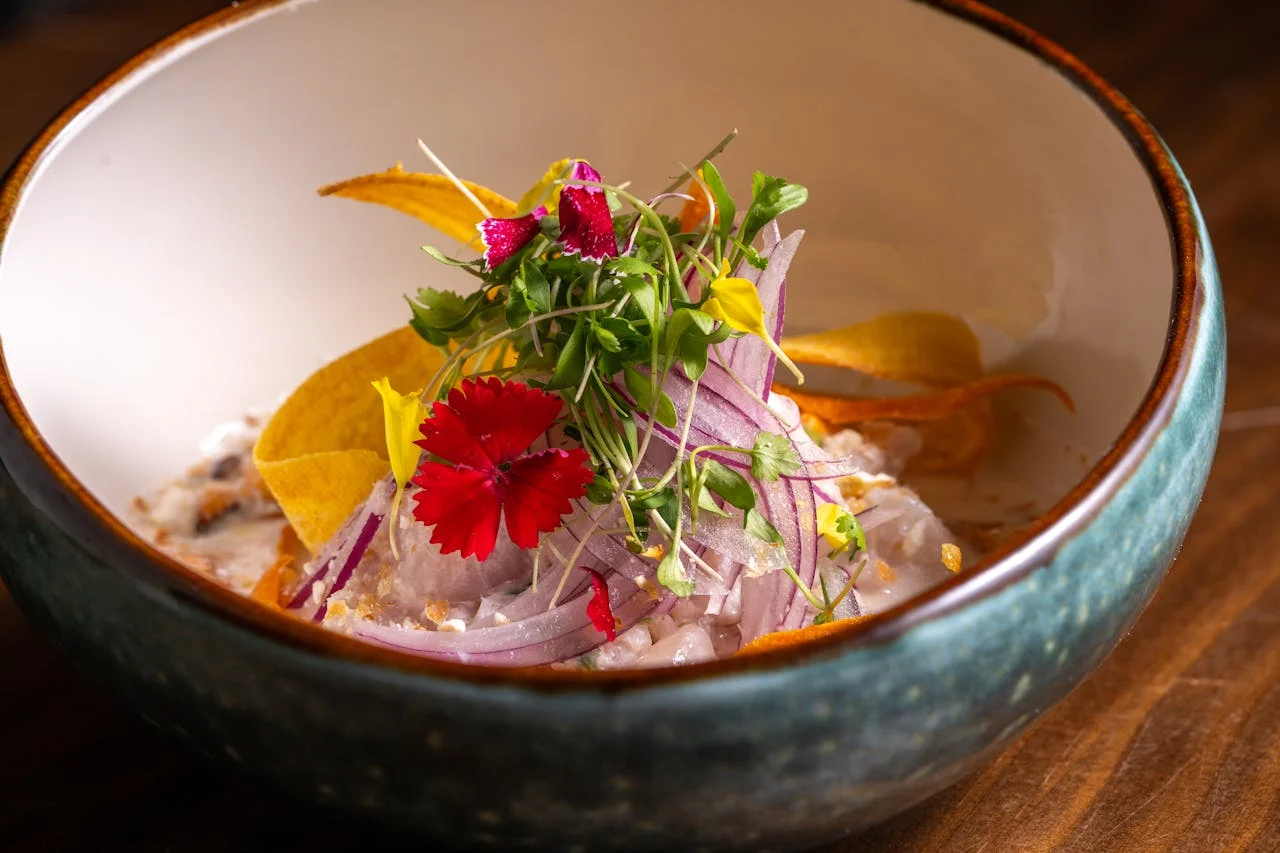Peruvian ceviche is more than just a dish; it celebrates the fresh, vibrant flavors that define Peru's culinary past. Ceviche, known for its simple yet bold flavors, has conquered palates around the world, becoming one of Peru's most iconic dishes.
Today, we'll delve deep into the heart of this national dish, discovering the bright world of Peruvian ceviche with leche de tigre (tiger's milk), a key ingredient that gives this dish its distinct kick.
What Makes Peruvian Ceviche Unique?
Peruvian ceviche is a delicious combination of raw fish marinated in freshly squeezed lime juice, sliced onions, cilantro, chili peppers, and salt. Leche de tigre, a citrus-based marinade that 'cooks' the fish without using heat, produces a refreshing and invigorating dish that is popular among both locals and tourists.
The Role of Tiger’s Milk
Leche de tigre, or tiger's milk, is the Peruvian term for the lime marinade used to make ceviche. This potent mixture, that's frequently spiked with garlic, ginger, and bits of fish, is so flavorful that it is occasionally served as a drink. It cures the fish in ceviche while also adding a strong, tangy depth that defines the dish's flavor profile.
A Taste of History
Ceviche's fascinating origins can be traced back over two thousand years to the ancient Moche civilization, which prospered on the northern coast of what is now Peru. The Moche were innovative in their culinary practices, first marinating their fish in the juice of the local tumbo (banana passionfruit), which established the tradition of acid-curing seafood.
As history progressed, the Inca Empire, which succeeded the Moche, continued to refine the dish. They introduced new ingredients like chicha, a fermented beverage made from corn that was also used to marinate fish. However, it was not until the Spanish conquest of the 16th century that the recipe underwent significant change. The Spaniards introduced new culinary influences, such as citrus fruits like limes and bitter oranges, which replaced the previous acidic juices. This introduction was pivotal because it significantly improved the dish's flavor and preservation method, giving birth to what we now know as Peruvian ceviche.
Furthermore, this period introduced other ingredients that became staples in Peruvian ceviche, such as onions and cilantro, adding to the dish's complexity and flavor. Ceviche evolved over the centuries, taking on various interpretations and styles based on regional tastes and available ingredients. Ceviche's basic components, including various fish and shellfish and ají peppers for a spicy kick, allow for a wide range of culinary experimentation.
Ceviche has become a modern-day symbol of Peruvian national identity and pride, representing the country's rich maritime heritage and diverse cultural influences. This dish not only illustrates the historical blending of indigenous and European culinary traditions, but it also demonstrates the dynamic nature of Peruvian food, which has embraced and adapted over millennia to produce a dish celebrated all over the world.
Each serving of ceviche tells a story of ancient traditions, colonial exchanges, and constant innovation, resulting in a profound culinary legacy that provides more than just taste but also a vivid glimpse into Peru's colorful past.
Creating the Perfect Ceviche: Ingredients and Preparation
To experience the authentic taste of Peruvian ceviche, freshness is key. Here’s how you can prepare it using traditional ingredients and techniques:
Ingredients:
1 kg of fresh white fish fillet (e.g., sea bass, halibut, or flounder), cut into 2 cm cubes
Fine slices of red onion
Minced chili peppers (ají limo or rocoto, depending on your heat preference)
Salt and black pepper to taste
Freshly squeezed lime juice (about 500 ml)
A handful of fresh cilantro, chopped
Sweet potato and Peruvian corn (choclo) for serving
For the Tiger’s Milk:
Small pieces of fish
Red or white onion (affecting the color slightly)
2 cloves of garlic
Minced chili pepper
Celery and ginger
Salt and a touch of sugar to balance the acidity
Detailed Steps to Prepare Authentic Peruvian Ceviche
Marinate the Onion:
Begin by preparing the onions, which will give the fish a crisper, milder flavor. Slice the red onions thinly and place in a bowl of salted water.
This process, known as desalting, helps to reduce the sharpness and pungency of the onions, making them more appealing and refreshing when combined with the fish.
Allow the onions to soak for about 15 minutes before draining and rinsing them with cold water to remove excess salt and soften the texture. Set aside to drain completely.
Mix the Fish:
For the best flavor and texture, choose high-quality, fresh white fish like sea bass, halibut, or flounder. Cut the fish into 2 cm cubes to ensure even marination and curing.
In a large mixing bowl, combine the cubed fish with the prepared onions. Season with finely minced chili (ají limo or rocoto for authentic Peruvian heat), salt, and freshly ground black pepper to taste.
Pour enough freshly squeezed lime juice to completely cover the fish. The lime juice will cure the fish, effectively cooking it without heat. Allow the mixture to marinate for at least 10 minutes, stirring occasionally to ensure that all of the pieces are evenly coated in lime juice.
Prepare the Tiger’s Milk:
Tiger's milk (leche de tigre) is the vibrant, citrusy marinade that gives ceviche its unique flavor. In a blender, combine small pieces of fish (trimmings from the fish you've prepared), chunks of onion, garlic cloves, chili slices, chopped celery, and a bit of fresh ginger for a fragrant kick.
Add roughly half of the lime juice used to marinate the fish, ensuring a strong flavor. To maintain texture, pulse the blender until the mixture is well combined but slightly coarse.
Strain the mixture through a fine sieve or cheesecloth into a bowl, pressing down on the solids to extract as much flavorful liquid as possible. The tiger milk should be tangy, spicy, and slightly thick.
Final Touch:
Pour the freshly prepared tiger’s milk over the marinated fish, stirring gently to combine everything. Taste and adjust the seasoning with additional salt, black pepper, and a small amount of sugar if the mixture is too tart. The sugar will not sweeten the dish but will balance the acidity of the lime juice.
Serve Immediately:
Peruvian ceviche is best eaten immediately after it is made. Serve the ceviche in bowls, topped with chopped cilantro for a herbal twist. To complement the fish's tangy flavor, serve with boiled sweet potatoes and Peruvian corn (choclo).
These sides not only add sweetness and texture to the meal, but they also increase its overall satisfaction.
Each step in making ceviche is critical to achieving the perfect balance of fresh, tangy, and spicy flavors that define this beloved Peruvian dish. With each bite, you can enjoy the vibrant taste of Peru!
Did you try the recipe? Mention @andeantravelexperience on Instagram or use the hashtag #AndeantravelExperience !
Celebrating Peruvian Ceviche
Recognizing its cultural significance, Peru honors this dish annually on National Ceviche Day, every June 28th, celebrating the rich history and enduring popularity of ceviche across the country and around the world.
Peruvian ceviche, particularly with leche de tigre, is more than just a meal; it's a culinary experience that encapsulates the spirit and flavors of Peru. Whether you're dining by the seaside in Lima or preparing it in your kitchen, each bite brings a taste of Peru’s coastal tradition right to your palate.
Peruvian ceviche is much more than just a culinary preparation; it is a symbol of Peru's rich history and cultural diversity, reflected in its fresh and vibrant flavors. This dish, with origins dating back over two thousand years to the Moche civilization and refined during the colonial era, blends indigenous traditions with European influences to create a unique experience. The inclusion of tiger's milk, with its bold, citrusy flavor, adds a distinctive touch that enhances the freshness of the fish and balances the spicy and acidic notes.
Each bite of ceviche tells a story of innovation and heritage, taking the diner on a journey through Peru's maritime traditions and cultural contributions. This iconic peruvian dish continues to win hearts worldwide, solidifying its place not only as a culinary delight but as a symbol of national pride and Peru's rich gastronomic heritage.
Are you ready to experience the authentic flavors of Peru firsthand?
Book your culinary adventure with us today and enjoy the zest of Peruvian cuisine in its natural setting. Experience the magic of dishes like ceviche the way they were meant to be enjoyed: fresh, vibrant, and surrounded by Peru's breathtaking scenery.
Don't just imagine it; actually eat it! Begin your culinary journey with us. 🍴✈️





